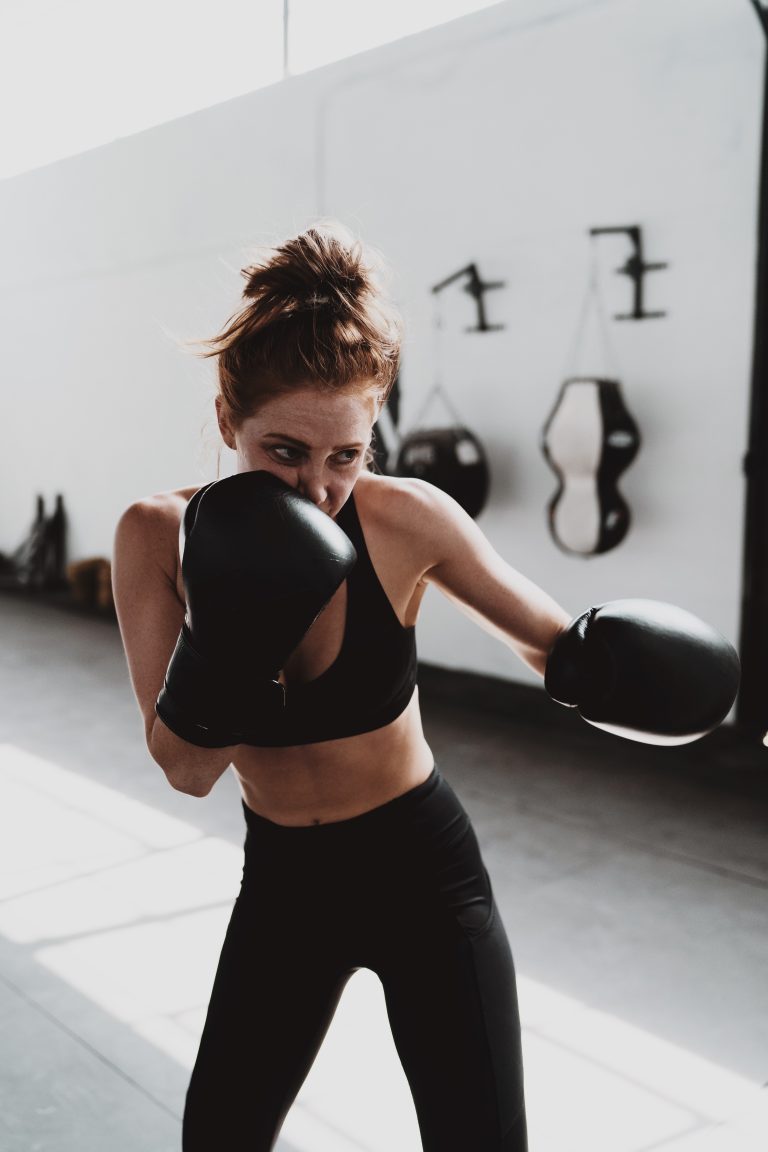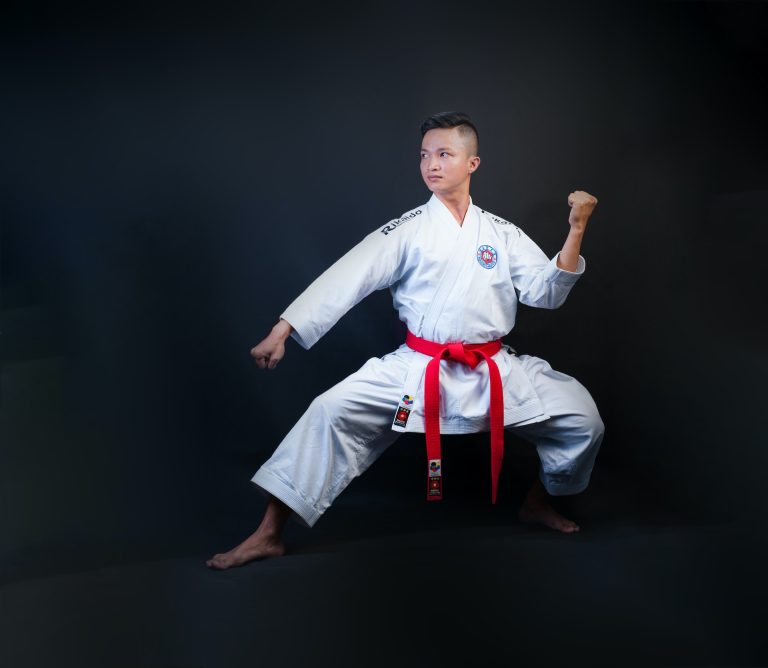Karate-Stellungen Anleitung
Karate ist eine effektive Kampfsportart, die aus Japan stammt und mit verschiedenen Techniken wie Schlägen, Tritten, Blockaden und Würfen arbeitet. Eine ihrer grundlegenden Aspekte sind die Stellungen, die eine solide Basis für die Ausübung der Techniken bilden. In diesem Artikel werden wir Ihnen eine Anleitung zu den grundlegenden Karate-Stellungen geben.
Zenkutsu-Dachi (Vorderfußstellung)
Die Zenkutsu-Dachi- oder Vorderfußstellung ist eine der grundlegenden Stellungen im Karate. Sie wird verwendet, um nach vorne oder zur Seite zu treten und um starke Schläge auszuführen. Hier ist, wie man richtig in die Zenkutsu-Dachi-Stellung kommt:
1. Beginnen Sie, indem Sie mit den Füßen zur Schulterbreite auseinander stehen. Ihr linker Fuß sollte 45 Grad nach links zeigen, während Ihr rechter Fuß geradeaus zeigt.
2. Treten Sie vorwärts, indem Sie Ihren linken Fuß einen großen Schritt nach vorne machen. Ihr linker Fuß sollte nun 70% Ihres Körpergewichts tragen, während Ihr rechter Fuß nur 30% trägt.
3. Beugen Sie das vordere Knie und halten Sie das hintere Bein vollständig gestreckt. Ihr hinteres Bein und Ihr vorderes Knie sollten in einer Linie sein. Halten Sie Ihren Rücken gerade und stellen Sie sicher, dass Ihre Hüften ausgerichtet sind.
Kiba-Dachi (Banditenstellung)
Die Kiba-Dachi- oder Banditenstellung ist eine grundlegende Stellung im Karate, die oft verwendet wird, um stabil zu bleiben und starke Blockade-Techniken auszuführen. Hier ist, wie man in die Kiba-Dachi-Stellung kommt:
1. Beginnen Sie, indem Sie mit den Füßen zur Schulterbreite auseinander stehen.
2. Treten Sie mit beiden Füßen gleichzeitig aus, so dass Ihr linker Fuß nach links zeigt und Ihr rechter Fuß nach rechts zeigt.
3. Beugen Sie die Knie und senken Sie Ihr Körpergewicht auf die Mitte Ihrer Beine. Halten Sie Ihren Rücken gerade und stellen Sie sicher, dass Ihre Hüften ausgerichtet sind.
Kokutsu-Dachi (Rückfußstellung)
Die Kokutsu-Dachi- oder Rückfußstellung wird oft verwendet, um rückwärts zu gehen oder starke Blockade-Techniken auszuführen. Hier ist, wie man in die Kokutsu-Dachi-Stellung kommt:
1. Beginnen Sie, indem Sie mit den Füßen aneinander stehen.
2. Treten Sie einen großen Schritt zurück mit Ihrem rechten Fuß, so dass Ihr Gewicht auf dem rechten Bein ruht.
3. Beugen Sie das hintere Knie und halten Sie das vordere Bein vollständig gestreckt. Ihr vorderes Bein und Ihr vorderes Knie sollten in einer Linie sein. Halten Sie Ihren Rücken gerade und stellen Sie sicher, dass Ihre Hüften ausgerichtet sind.
Fazit:
Die Karate-Stellungen bilden eine solide Grundlage für eine erfolgreiche Kampfkunstpraxis. Die Zenkutsu-Dachi-, Kiba-Dachi-, und Kokutsu-Dachi- Stellungen sind die grundlegenden Stellungen, die jeder Karate-Schüler beherrschen sollten. Durch regelmäßiges Üben und Fortschritt wird die Technik beherrscht.
The Most Frequently Asked Questions About Karate Stances Guide
Karate is a martial art that uses stances as the foundation for different techniques. Stances are an essential element of Karate, as they provide power and balance to the practitioner’s movements. In this post, we will delve into the most frequently asked questions about Karate stances.
1. What are the basic karate stances?
Karate has five basic stances that serve as the foundation for more advanced techniques. These stances are:
- Horse stance or Kiba-dachi
- Cat stance or Nekoashi-dachi
- Back stance or Kokutsu-dachi
- Front stance or Zenkutsu-dachi
- Parallel stance or Heisoku-dachi
Each of these stances has different applications and purposes. These stances are used for stability, mobility, generating power, and positioning for striking or defensive maneuvers.
2. How important are stances in karate?
Stances are the foundation of Karate techniques. They provide a stable base that allows the practitioner to generate power and execute their techniques with precision, speed, and balance. Stances are essential for developing a strong Karate foundation and improving the effectiveness of Karate techniques. Proper execution of stances helps to develop the necessary muscle memory, speed, power, and balance required in Karate.
3. How can I improve my Karate stances?
To improve your stances in Karate, you should:
- Practice regularly – Consistency is essential for improving your stances. It would help if you practiced your stances daily to develop your muscle memory, balance, and power.
- Focus on proper form and technique – The proper form and technique are important to maximize the effectiveness of the stance. You should focus on maintaining the correct posture, alignment, and positioning when practicing your stances.
- Work on flexibility – Flexibility in Karate is essential to maximize your power and range. Stretching exercises can help to improve your flexibility and mobility when executing your stances.
- Train with a partner – Practicing your stances with a training partner can help you to develop your balance, coordination, and timing. You can also receive feedback from your partner to improve your technique.
4. What are the common mistakes people make when practicing their stances?
The most common mistakes people make when practicing their stances include:
- Lack of stability – People often lose their balance when performing their stances, which can result in poor technique.
- Incorrect posture – Poor posture can affect your balance and reduce the effectiveness of your stance.
- Incorrect foot positioning – Foot positioning is essential when executing a stance, and incorrect positioning can result in reduced power and balance.
- Lack of flexibility – Lack of flexibility can limit your mobility, range, and power when executing Karate techniques.
5. What are the benefits of practicing Karate stances?
The benefits of practicing Karate stances include:
- Developing muscle memory – Practicing your stances regularly helps to develop your muscle memory, making it easier to execute your techniques with speed, power, and precision.
- Improving balance and stability – Proper execution of stances helps to improve your balance and stability, which is essential in Karate.
- Developing power – Stances are an essential element in generating power in Karate techniques. Practicing your stances correctly helps to improve your power and efficiency.
- Improving flexibility and mobility – Flexibility is essential in Karate, and practicing stances can help to improve your range of motion and mobility.
6. How do I know if I am executing my stances correctly?
You can know if you are executing your stances correctly by:
- Feeling stable and balanced – If you feel stable and balanced when executing your stances, then you are likely performing them correctly.
- Proper alignment and posture – Proper alignment and posture are essential when executing your stances. If your posture and alignment are correct, then you are executing your stances correctly.
- Effective execution – If you can execute your Karate techniques effectively from your stances, then you are performing them correctly.
- Feedback from a qualified instructor – A qualified Karate instructor can provide feedback on your stances to help you determine if you are executing them correctly.
7. Are stances used in sparring?
Yes, stances are used in sparring. When sparring, proper execution of stances becomes crucial in generating maximum power, impact, and mobility. The use of proper stances in sparring also helps to maintain balance, stability, and reaction time.
Conclusion
In conclusion, stances are a crucial element in Karate techniques. Practicing stances regularly helps to develop muscle memory, improve balance and stability, and generate power. With consistent practice, correct technique, and dedication, you can improve your Karate stances, and become a skilled Karate practitioner.
Inhaltsverzeichnis






